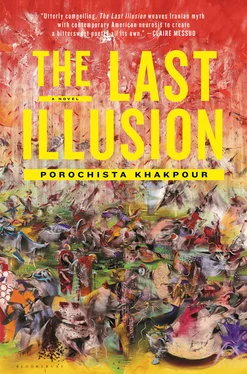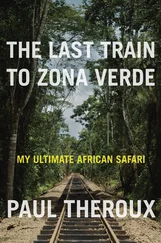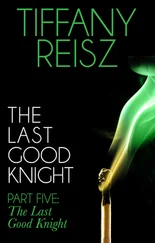Perhaps possibly, someone else would say.
But the odds, another would say.
Meanwhile, they tracked the boy’s descents and ascents — shriek to song, grimace to bawl, cuddle to hurl, off and on and on and off — as if there were even logic in this world.

“Zal’s Crisis,” a headline in the Tehran Times declared. The story featured ample speculation from the doctors who worked with him daily and who were growing more and more concerned for the boy as he aged. It also featured the young filmmaker who had first seen the boy, who had done more than anyone to spread Zal’s story beyond the border of Iran, whose three-hour documentary Zal Lives had won awards around the world and broken the hearts of many a man and woman who could not locate Iran on a map.
It was the filmmaker who first got the letter from Anthony Hendricks, a New York child psychologist and feral children researcher who was interested in coming to Iran to set up a meeting with Zal.
The young filmmaker, with little connection to Zal and his world, had simply relayed the number of the home and said it was all he could do really.
But by the time Hendricks came to Tehran three months later, something inside the filmmaker — perhaps some indebtedness to this story that had catapulted him from mere student of film to one of the world’s most sought-after documentarians, this link to a life that he had barged in on and frozen and capitalized on like an earnest but profiting almost-Audubon, this bond that would be in some ways a forever-connection to everything Zal — all this had prompted him to be there at the airport to greet Hendricks, one hand extended in a shake, the other perched on his camera, about to film what was effectively the sequel.
In the film he comes out of customs, a giant man with white beard, big belly, laughing eyes, in a too-tight beige tweed suit and bow tie, all Santa-Claus-gone-professor pleasant looks. The sound of the filmmaker’s chuckles at his image are caught on the film, and then Hendricks himself laughing, and then saying, “Well, adventure of adventures! Tony Hendricks here! Salaam, chetori ?”
The filmmaker had lowered his camera, shocked by the man’s pitch-perfect Persian salutation.
He had been married to an Iranian woman who years ago had died, Hendricks explained, his eyes still laughing.
“I am so sorry,” the young filmmaker said. “No children of your own?”
Hendricks had shaken his head. “She couldn’t. She was sick since I met her. A long struggle.”
“I am even more sorry,” the filmmaker said. “You are so kind to come see this child that nobody can care for anymore. It’s such a tragedy. He has family, but none of them will claim him. They are too ashamed. I would take him if I could.”
“Don’t worry,” Hendricks said, with real confidence. “He will be taken care of, that I promise.”
But the filmmaker did not imagine Hendricks meant he would care for the boy himself. In fact, when the papers reported this American scientist Hendricks was adopting Zal, nobody believed it. They thought the home had simply paid him to take the kid, not the other way around.
Zal and Hendricks lived in a temporary apartment in Tehran’s north side for several months. It was important to Hendricks that Zal be near his medical team and slowly get to know his homeland. They took walks together — Zal from wheelchair to walker — and sat in parks. After a while Hendricks read to him and saw glimmers of peace in the boy, peace that had to be indication of thought.
The boy was maybe, just maybe, thinking — thinking as we do.
A few papers called him “Zal’s Ann Sullivan,” and one cruelly printed a photo of them in the park, a hysterical Zal amidst a fit, clawing at Hendricks’s hair and beard, and Hendricks in a sort of composed agony, trying to contain the little savage of his, with apparently little luck.
Given the nature of Zal’s nightmares, Hendricks made sure they always slept in the same room. Zal Hendricks, he would always say to his son before bedtime, with an index finger poised like a gun barrel against the boy’s heart, as he lay — finally lay! — in the twin bed that flanked Hendricks’s double bed. You: Zal Hendricks .
In those months in Tehran, often after Zal fell asleep, Hendricks would take out his translated copy of the Shahnameh and read Zal’s namesake’s sections to himself. Who could say whose story was worse? His Zal was not exactly an albino but a white-blond child in a family of raven-haired folk, in a nation almost entirely of raven-haired folk. But in the Shahnameh, Zal grew into such a great hero that the father who had abandoned his too-white freak child in the wilderness to be raised by the giant godlike bird, the Simorgh, came back to claim him. The Simorgh reluctantly returned Zal, though forever remained his guardian angel through all his many victories and travails. And in spite of Zal’s “old man’s hair,” he was described as possessing “a body like a cypress tree,” or else a lion’s, and a “chest like a mountain of silver” and “cheeks as fresh as spring”; he evolved into “a shining star” and ultimately a ruler of a kingdom, a man — all man, a real man — whose greatest challenge in the end was capturing the most beautiful woman in the world and keeping her, against all odds.
Of course, it was just a story, but sometimes for Hendricks it had the feel of a session with a well-reputed astrologer. It could all be — and it likely was — bunk, but what marvelous bunk. He was reminded of that old feeling he used to have — one that some hand-me-down rationality would try fruitlessly to deny — that you could wish things into being if only you tried hard enough. Of course, until Zal he had never considered that a being could be wished into being if some other source or combination of sources willed it enough. His mind ran away with glorious possibility: that darkly glittering will of the cosmos conjuring through some magical combo of, say, blood, guts, sun, sky, and spirit— and isn’t that how every human is made anyway? he tried to argue, with whom he did not know. Isn’t that how every story is created?

Hendricks, an only child, had always wanted a child of his own. This was perplexing to those around him, even his mother, who ended up caving to her young son’s pleas and buying him doll after doll, which he’d undress, put in diapers, pretend to feed, sing to, and sleep with. He would teach walking and talking and counting and spelling, basically transferring any and all schoolwork to his own classroom of dolls. It was disturbing to Hendricks’s mother, a single mother who already had more than enough in her life to be disturbed by. She was a hard-drinking down-and-out waitress with notorious anger issues, who was left by or had left a long line of men, including Hendricks’s father, whose left/was-left-by status might as well be left to the toss of a coin, his exact identity was so foggy. More than once she did not come home in Hendricks’s early childhood, leaving him in the hands of neighbors and friends and an odd grandparent or two and, once in a while, by himself.
So as a child, the only home Hendricks really knew was the home he was in charge of creating.
Besides, he’s not like other kids, she said to a concerned neighbor once, who had seen him earlier peering out a window, naked, watching his mother drive off. She had claimed it was an emergency, but the neighbor could smell the alcohol on her breath . I raised my son to be better than any other kid on this earth, and so you can’t hold him to those standards. I know what he can and can’t do, and frankly, this kid can do it all, honest.
Читать дальше














